

75 YEARS AGO . . . . . EVENTS IN TAIWAN POW HISTORY
2020 is the 75th Anniversary of the end of World War II, and we want to share with our readers a chronology of events that took place in 1945 relative to the Taiwan POWs, to help commemorate their suffering and sacrifice. 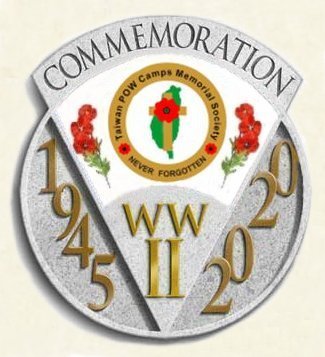
JANUARY
9th - As General Macarthur’s forces made the second major amphibious landing on the Philippines in the Lingayen Gulf, aircraft from the US Navy carrier Hornet attacked Takao (Kaohsiung) Harbour. The hellship Enoura Maru - part of a convoy of ships that had left the Philippines on December 27th carrying mostly American POWs bound for Japan, was bombed and more than 300 POWs were killed. The ship did not sink and the remains of the dead POWs were subsequently buried in a mass grave on Chijin Island. In 1946 the American War Graves Recovery Team removed the remains and sent them first to Shanghai and later to Hawaii for permanent burial in 20 communal graves at the Punchbowl Cemetery.
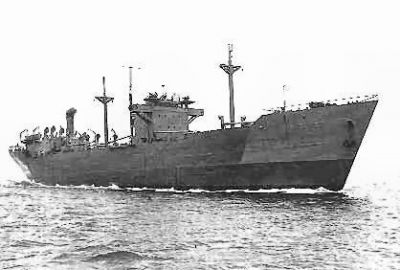 In 2005 the Taiwan POW Camps Memorial Society held a memorial service at Kaohsiung Harbour with one former American POW from the Enoura Maru present. It was then decided to build a memorial to the almost 30,000 POWs who had suffered and those who died on the hellships in Taiwan waters.
In 2005 the Taiwan POW Camps Memorial Society held a memorial service at Kaohsiung Harbour with one former American POW from the Enoura Maru present. It was then decided to build a memorial to the almost 30,000 POWs who had suffered and those who died on the hellships in Taiwan waters.
The Enoura Maru
In 2006 the Taiwan Hellships Memorial – co-sponsored by the Society and the City of Kaohsiung, was dedicated at Chijin Beach with several family members of the former POWs who died present for the ceremony. Ironically the location of the memorial is right across the road from the site of the former mass grave. The memorial is a part of the 'War and Peace Park' which was dedicated on May 20, 2009 and honours the Taiwanese veterans of three conflicts - WWII, the Chinese Civil War and Korean War.
In 2018 the Taiwan POW Camps Memorial Society and the American Defenders of Bataan & Corregidor Memorial Society succeeded in getting a memorial stone placed on the Memorial Walk at the Punchbowl Cemetery in Hawaii in honour and memory of the men who died aboard the Enoura Maru. 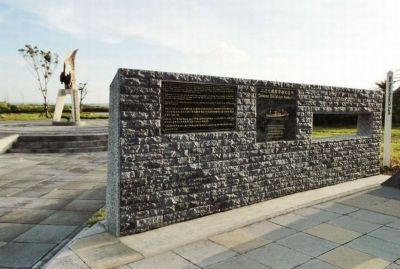
The Taiwan Hellships Memorial, located in the War and Peace Park, Chijin, Kaohsiung, Taiwan
15th - Approximately 1,100 POWs who had come to Taiwan in November 1944 on the Hokusen Maru and had spent the previous two months in various camps on the island, and a few who had come on the Enoura and Brazil Marus, were gathered together at Takao and Keelung and sent to Japan on the Melbourne Maru and the Enoshima Maru. Many went to Kyushu, while others went to the Tokyo, Osaka and Sendai areas where they finished out the war.
28th - A PB4Y-1 aircraft the 'Queen Bee' of US Navy Squadron VPB-117 based in the Philippines was shot down over Tung Kang Harbour south of Kaohsiung while on an anti-shipping bombing mission. Four of the crew died in the crash and the others were captured and taken prisoner. One more crewman died the following week from injuries suffered in the crash and another was sent to Japan for interrogation. The other five were sent to Taihoku (Taipei) and were incarcerated in the Taihoku Prison. They were later given a mock trial, found guilty and murdered by the Japanese just 58 days before the war ended. 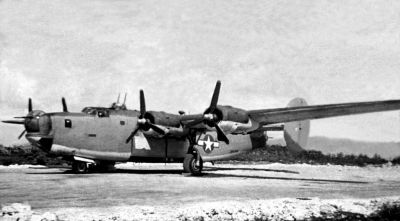
PB4Y-1 of VPB-117 at Tacloban Philippines, January 1945
FEBRUARY
7th - During an attack on southern Taiwan, Heito Camp was bombed by aircraft from the famous 90th Bomb Group USAAF flying B-24 's. They were escorted by P-38's of the 475th Fighter Group. 28 POWs were killed and about 80 were injured. One Japanese guard was killed and several more were injured. The Japanese provided no medical care for the injured POWs, resulting in more deaths over the next two months. In early March Heito Camp was closed and the POWs were dispersed to Taihoku Camp #6, Toroku and Shirakawa.
21st - 207 POWs from Kinkaseki, 140 from Taihoku Camp #6, 69 from Heito, 6 from Inrin, and 279 from Shirakawa - totaling 701, were assembled at Keelung for a voyage to Japan. They initially set off on the Melbourne Maru, but it ran aground and had to return to the port. The men were held there for a week and then loaded aboard the Taiko Maru which departed on March 1st. This was the last shipment of POWs to leave the island. Most went to camps on Kyushu with some going to Hakodate in northern Japan. Some of the officers later went on to Manchuria where they finished the war.
MARCH
5th - 43 POWs from Inrin Camp – all of whom had originally been in Taichu Camp, were moved to Toroku Camp which formerly contained American POWs off the hellship Hokusen Maru. The majority of the American POWs had left the island in January on the Melbourne Maru and Enoshima Maru, but 18 sick men remained and were joined by the British POWs from Inrin. At this time Inrin Camp was closed.
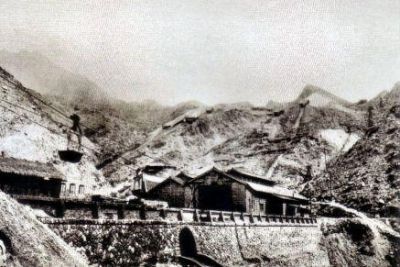 9th - The infamous Kinkaseki copper mine was closed as the ore could no longer get through to Japan for processing. The POWs just stayed in the camp with their food rations cut and awaited an unknown fate.
9th - The infamous Kinkaseki copper mine was closed as the ore could no longer get through to Japan for processing. The POWs just stayed in the camp with their food rations cut and awaited an unknown fate.
The infamous Kinkaseki copper mine.
11th – Heito Camp was closed and 128 men were moved from there to Taihoku Camp #6, and 13 sick men were sent to Toroku Camp. Two American and two British POWs died in the following month the men spent in Toroku Camp.
22nd - Following the close of the Kinkaseki mine earlier in the month, Major Wheeler and two medical orderlies took 86 of the sickest men to Shirakawa Camp. Upon reaching Taihoku, 36 men were added and some were subsequently dropped off at Toroku Camp en route. By this time, and with the departure of most of the senior officers to Manchuria in October 1944, Shirakawa had become a sort of hospital camp. However, 15 of the former Kinkaseki men died later at Shirakawa from malnutrition, various diseases and overwork in the mine.
30th - 35 more men left Kinkaseki for Taihoku Camp #6 where they remained til the end of the war.
APRIL
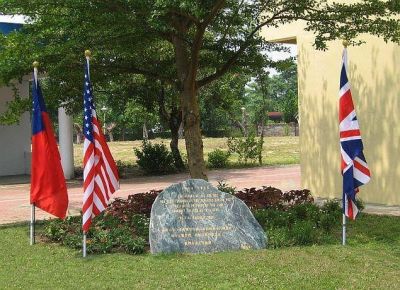 11th - Toroku Camp was closed and the men were moved to Shirakawa Camp were they finished the war.
11th - Toroku Camp was closed and the men were moved to Shirakawa Camp were they finished the war.
In 2009 the Taiwan POW Camps Memorial Society erected a memorial to the men who were interned in Toroku Camp at the Gou-ba Elementary School near Douliou – the site of the former camp. (See our Spring-Summer 2009 newsletter for more info.)
In late April the Japanese decided to re-locate all the remaining POWs at Kinkaseki Camp to the hills south of Taihoku. Kinkaseki first needed to be cleared of all supplies and stores, and the POWs were detailed to do this task. For the next three weeks they carried material to the railhead in preparation for the move. A group of 100 men was selected to be the advance party to get the new camp ready for the rest of the men who would follow at the end of May and in June.
MAY
16th - The 'advance party' left Kinkaseki and travelled to Taihoku and Shinten by train and then were forced to march 10 kms up into the hills carrying whatever supplies they could. A camp was set up at Kukutsu and the men began to build huts as there was no accommodation for them in the jungle environment. At Taihoku the men were joined by a group of five American POWs and one British POW – all medical personnel, who were attached to the group at the last moment. Now there were doctors in the camp again.
29th - A mock trial was held at the Japanese Military Court in Taihoku for fourteen of the American airmen who had been shot down over Taiwan in the previous eight months. Five of those were from the PB4Y-1 Liberator 'Queen Bee'' that had been shot down over Tung Kang Harbour on January 28th. Although the charges were all trumped up and they had no defense, all were found guilty and sentenced to death by the Japanese War Crimes Tribunal. They were returned to Taihoku Prison to await their execution.
30th - The second group of men left Kinkaseki and joined the initial group at Kukutsu. In addition to helping with the construction of the huts, some of these men were also put to work digging up an old tea plantation on the hills near the camp and planting sweet potatoes and peanuts. This was terrible, back-breaking work given the near starvation conditions they were living in.
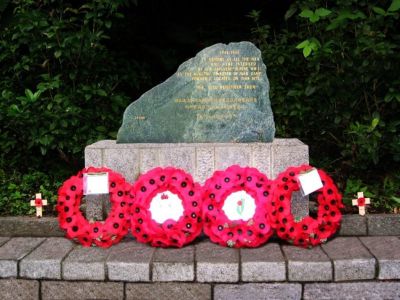
The site of the former Kukutsu Camp was discovered in 1997 and in 1999 the second POW memorial in Taiwan was erected to the men who suffered there. In 2004 the memorial was re-located to a better and more secure location and very often memorial services are held there by the POW Society and the local residents of the area.
JUNE
2nd - Shirakawa Camp was strafed by US Army Air Force P-38 fighter planes – no damage was done and no-one was killed or injured.
In early June 1945 the Japanese authorities at the main Taihoku Camp #6 decided to send a group of POWs up into the mountains southwest of the city to build a temporary camp to “protect the prisoners from the extensive bombings of the capital”. In fact the POWs were to be killed up there when the Allies landed on Taiwan.
12th - 100 men from Taihoku Camp #6 were sent to an area in the mountains near the town of Sanxia, to build a camp which they named Oka Camp.
The group arrived at a small village on the mountainside and from there they had to trek the rest of the way to the camp area. They began to build huts for the rest who would follow soon after.
16th - The last party of men left Kinkaseki Camp and travelled the same arduous route to the jungle camp at Kukutsu. They joined their mates in what was to become an even worse time for them than at Kinkaseki, with forced hard labour, beatings, starvation and increased sickness and disease. Their only means of obtaining food and supplies was through the daily 'town parties' who would walk the 10 kms to and from Shinten, bringing them into the camp.
19th - At 6:00 am the 14 American airmen, supposedly found guilty in the mock trial of May 29th, were led out into the courtyard of the Taihoku Prison and shot to death by a Japanese firing squad. The youngest was only 20 years of age. This was a needless execution as the Japanese knew they were losing the war which ended 58 days later. They could have kept the men in prison with the rest of the airmen who they released at the surrender.
On June 20th 2009 (June 19th in the USA) – 64 years to the date of the execution, a memorial plaque erected by the Society was unveiled on the wall of the old prison in honour and memory of the men who were imprisoned and those who needlessly died there.
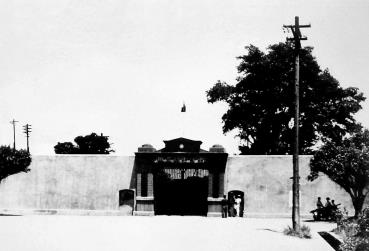
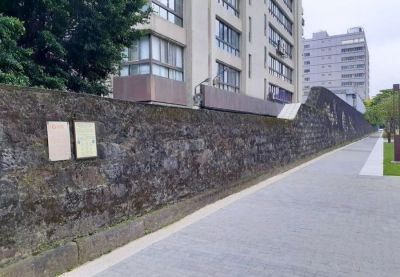
Taihoku Prison during wartime . . . The former prison wall today . . .
JULY
1st - Oka Camp opened and 50 more men came up from Taihoku Camp #6 on July 2. By this time most of the first group of 100 men was too sick and weak from starvation to work, but the building of the huts continued. By the end of July out of the 150 men in the camp only about 40 were fit for any kind of work.
Conditions for the men from Kinkaseki at the Kukutsu 'jungle' Camp continued to worsen as the summer wore on. Forced to work on the mountainside planting sweet potatoes and peanuts (which they never got to eat) and though they were starving, if caught eating when planting they would be severely beaten – a risk which many took and suffered. The men had to scrounge for food, eating mice, rats, snakes and snails and the local grasses shown to them by the Taiwanese. Their only real food was rice which was hauled up from Hsinten City every couple of days on the backs of the emaciated prisoners. Most have testified that this was their worst time as a POW.
Conditions worsened as well at Shirakawa Camp in the south of the island, and although the camp was supposed to be a sort of hospital camp, food was getting scarcer as the blockade tightened around the island. Rations were cut further and men continued to die despite the efforts of the camp POW medical personnel.
AUGUST
The misery of the POWs everywhere continued while the allies tried to persuade the Japanese to surrender. Finally the two atomic bombs were dropped on Hiroshima and Nagasaki on August 6th and 9th, forcing the Japanese to give up the fight. The official surrender came on August 15th.
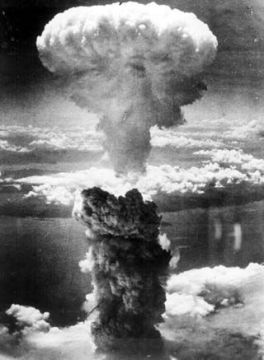
However, despite the rumors that the war had ended, conditions in the camps remained almost the same for another week. Although the work details ended and the food rations were increased slightly, the POWs were still under the thumb of their captors. The POWs at Taihoku Camp #6 were the first to learn of the war’s end and the men from Oka Camp returned to Taihoku on the 21st. Ten men had died in this camp in just 2 ½ months, and nine more died after their return to Taihoku Camp when the war ended.
The men at Kukutsu did not know the war had ended until the 18th - and just after that the second man died in the camp on the 22nd. Then the POWs had to endure another arduous journey back down the mountain to Taihoku carrying many sick and dying men. They were promised boats and trucks to help them, but none ever came. By the time this group reached their new temporary camp at Churon near the Matsuyama Airfield in Taihoku two more men were dead.
The men at Shirakawa were finally informed that the war had ended in a speech by the camp commandant on the 22nd. On the 26th they were sent north by rail to Taihoku and placed in an evacuated Japanese hospital they called Maruyama Camp, arriving there on the 27th.
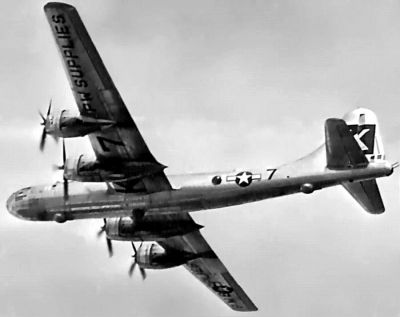
28th - US Army Air Force B-29’s from Saipan dropped much-needed food and supplies on the three camps located in Taihoku - Taihoku Camp #6, Churon Camp - which was located near the airport, and Camp #4 at Maruyama. The planes came in too low for the drop and many of the parachutes didn’t open in time so the canisters came crashing to the ground in the camps causing a lot of damage and injury. At Taihoku Camp #6 a canister came through the hospital hut roof and two men were killed, and at Churon several canisters hit the POWs’ building and killed three men who were in the hospital area on the second floor. Several more were injured. No accidents occurred at Maruyama Camp.
30th - More B-29’s returned for a second drop on the camps but this time there were signs laid out on the ground telling them where to drop and no-one was injured or killed. The food and supplies dropped on the camps were a life-saver for the sick and starving men. Notes were dropped telling the POWs that rescue was on its way.
SEPTEMBER
1st - A party of five American Navy and Army personnel arrived in Taihoku by boat from China to assess the immediate needs and arrange for the evacuation of the POWs.
2nd - The formal Japanese surrender took place on the battleship USS Missouri in Tokyo Bay bringing World War II to an official close.
4th - A group of US Navy ships arrived off Keelung Harbour to begin the evacuation of the POWs. Two Escort Carriers - the USS Block Island CVE-106 and the USS Santee CVE-29, anchored about 30 miles out at sea while escort ships patrolled nearby.
5th - Fighter aircraft from both carriers flew sorties over Taihoku and Northern Taiwan to make a show of force to the Japanese while two US Destroyer Escorts – USS Thomas J. Gary DE-326 and USS Kretchmer DE-329 navigated their way through dangerous minefields and entered Keelung Harbour. Supplies for the POWs were also landed by some of the carrier aircraft and dispersed to Maruyama Camp.
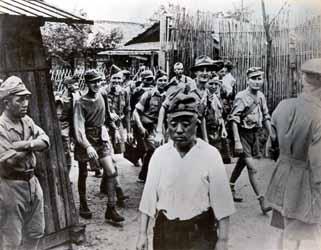
In the afternoon the ex-Kinkaseki POWs from Churon Camp were taken by train to Keelung Port and put on the two destroyer escorts and taken out to the waiting carriers. The men had to transfer from the DE’s in fairly rough seas but all were loaded safely.
6th - The following morning the Gary and Kretchmer were joined by DE’s USS Brister DE-327 and USS Finch DE-328 in ferrying the POWs from Camp #6 and those who had been at Shirakawa and Maruyama from Keelung to the carriers.
Happy POWs leaving Taihoku Camp #6 on September 6, 1945.
Later in the afternoon as the Americans were nearly finished evacuating all the prisoners they could take, a group of British Royal Navy ships – including the famous cruisers HMS Belfast and HMS Bermuda, entered the harbour. The New Zealand hospital ship Maunganui arrived three days later to take off the remaining hospital cases who were too sick and weak for the Americans to handle. They remained at Keelung for the next two days gathering up sick prisoners from the hospitals before sailing for Manila.
Once the American DE's had delivered the last of their precious cargo to the carriers and loaded 50 POWs each, the task force departed for Manila, arriving there on September 9th.
8th - Transport aircraft from the Philippines evacuated 27 POWs out to Manila by air.
12th - The New Zealand hospital ship Maunganui departed from Keelung with the remaining 101 POWs who were too sick to travel on the regular US Navy transports.
On arrival in the Philippines, the POWs were offloaded and taken to hospital repatriation depots run by Australian and American Forces where they were given medical treatment and care before being allowed to return home again.
Within a few weeks as transport could be found, the POWs were on their way home. Some went by way of Singapore, Ceylon and the Suez Canal while the majority went across the Pacific to Canada and the USA, with a great many going across Canada by train to the east coast where they boarded ships like the Queen Mary and Queen Elizabeth for their final journey back to the UK and home. Most arrived home in November and before Christmas. The Americans were repatriated home through the ports of San Francisco and Seattle.
Some of the POWs required further medical care and treatment and so were taken by the hospital ship Maunganui and other ships to Australia and New Zealand where they recovered and rested until being shipped home – some as late as the spring of 1946.
The men who were imprisoned on Taiwan as POWs can not and will not ever forget their experiences, and we who seek to tell their story and honour them will not forget either!
<< Back to list page - Email this Page
© COPYRIGHT 1998 - 2024
All material on this website, including articles, maps, photographs, drawings etc. is the copyright of the
Taiwan POW Camps Memorial Society
and/or those people or organizations who have contributed such material. We are happy for material on the Taiwan POW Camps Memorial Society site to be used for schools or research purposes, provided reference is made to its source and/or the owner.
No material may be used on another website or reproduced in any manner by any other means or method without permission from the
Taiwan POW Camps Memorial Society.
All material on this website, including articles, maps, photographs, drawings etc. is the copyright of the
Taiwan POW Camps Memorial Society
and/or those people or organizations who have contributed such material. We are happy for material on the Taiwan POW Camps Memorial Society site to be used for schools or research purposes, provided reference is made to its source and/or the owner.
No material may be used on another website or reproduced in any manner by any other means or method without permission from the
Taiwan POW Camps Memorial Society.